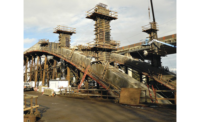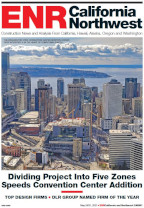While recovery efforts continued following the May 27 barge collision and collapse of a bridge over the Arkansas River, the Oklahoma Dept. of Transportation on May 28 hired engineer Poe & Associates Inc., Oklahoma City, to prepare repair plans within 16 days.
ODOT Chief Engineer Bruce Taylor says he expects to hire a contractor as soon as the plans are delivered. The repair is estimated to cost $10 million.
"We feel the very real responsibility to put this bridge back into commission as fast as possible," says Herschel Walker, ODOT secretary. "That thing took one heck of a wallop, but it's a very stable structure apart from the west end."
At least nine people were killed when two attached barges struck and collapsed the Interstate 40 bridge in eastern Oklahoma. A 104-ft-long tugboat was pushing the barges, owned by Vicksburg, Miss.-based Magnolia Marine Transport Co., up the river. The empty barges, weighing a combined 800,000 lb, were 300 ft from the bridge when pilot Joe Dedmon apparently blacked out.
At 7:45 a.m., the 54-ft-wide, 280-ft-long barges began drifting at 5 mph. They missed the navigation channel by 300 ft and hit three piers at the bridge's west end. Two piers shattered and a third tilted, causing 500 ft of deck sections to pancake. Up to 15 vehicles drove into the 11-ft-deep river.
"The impact of the collision would have been roughly equivalent to five 2,000-lb cars slamming into the structure simultaneously at 60 mph," says Steven Tipton, an associate engineering professor at the University of Tulsa. Mary Beth Hudson, spokesperson for the U.S. Army Corps of Engineers, notes that the river was flowing at 54,000 cu ft per sec, well below the normal 70,000-cu-ft-per-sec average. The Corps has lent a barge-mounted 175-ton crane and sonar equipment to the recovery effort, led by a 14-member National Transportation Safety Board team and the U.S. Coast Guard.
The four-lane bridge, which carries 20,000 vehicles daily, is part of a truck route between Barstow, Calif., and Wilmington, N.C. Traffic is being rerouted 20 miles away, heavily impacting interstate commerce.
Built in 1967, the 64-ft-wide, 1,988-ft-long bridge consists of two post-tensioned concrete decks set atop steel girders. The 13-span crossing, which has a 300-ft clearance, is supported by 10 piers, each roughly 48 in. in diameter. It received a 78 of 100 rating when it was inspected last year, with negligible abrasion to the pilings.
ODOT believes it can still utilize the remaining bridge structure and span the cavity with concrete girders. A contractor or engineer has yet to be named.




